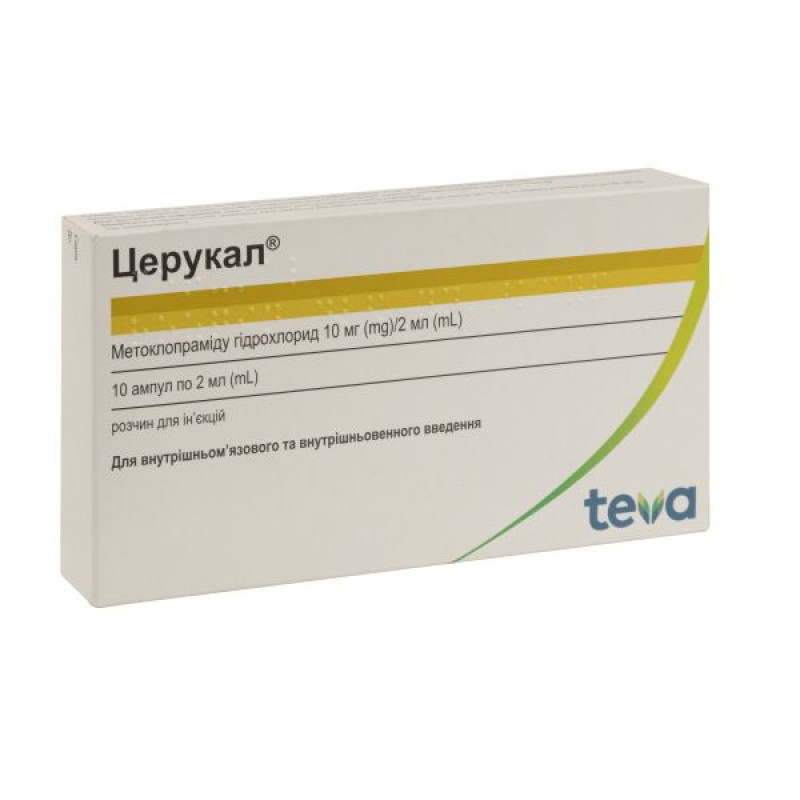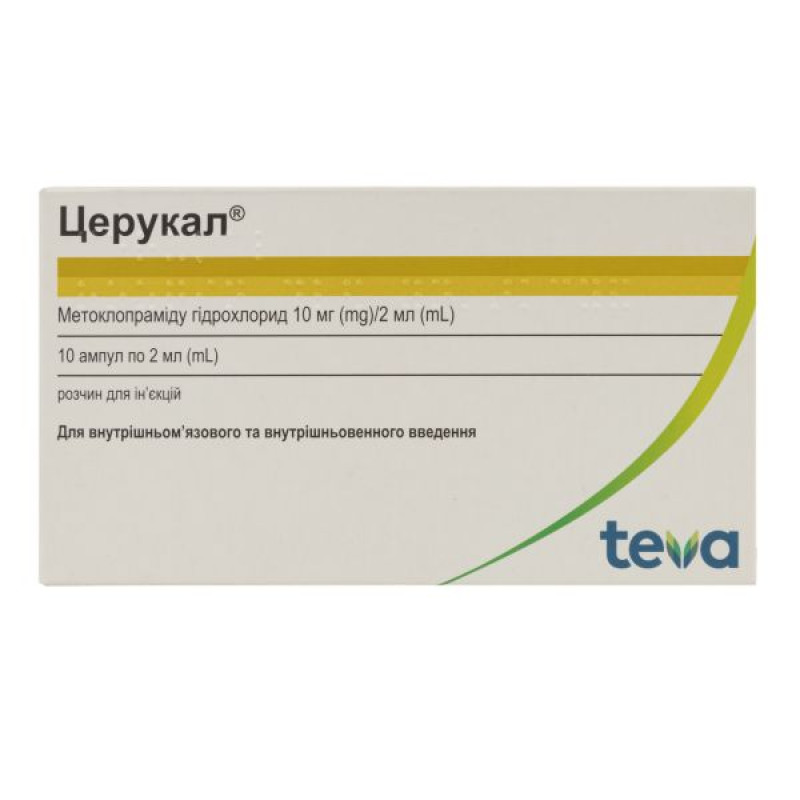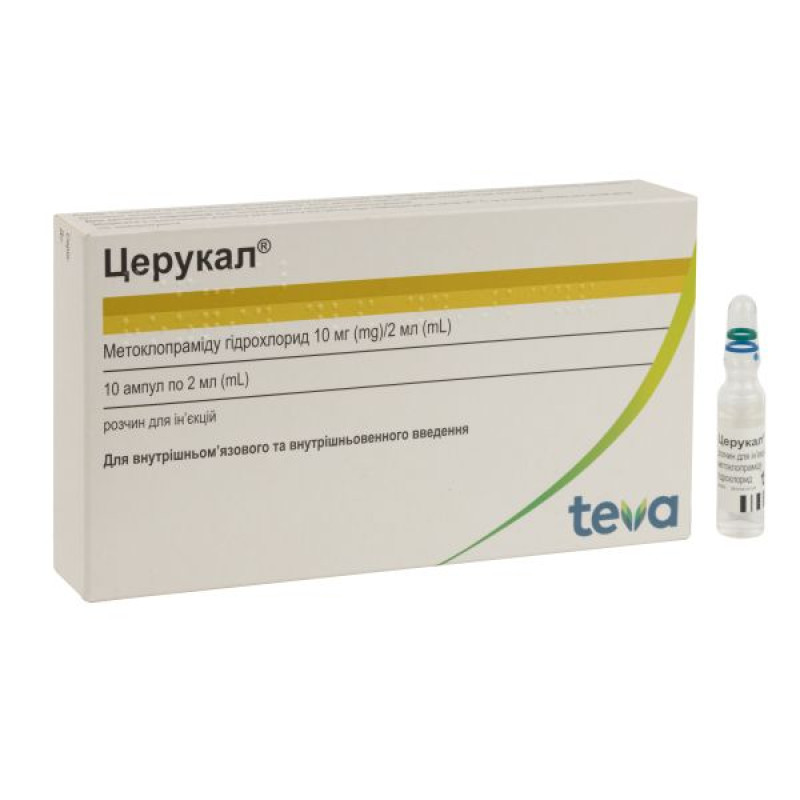Cerucal solution for injection 10 mg ampoule 2 ml No. 10

Instructions Cerucal solution for injection 10 mg ampoule 2 ml No. 10
Composition
active ingredient: metoclopramide hydrochloride;
1 ampoule (2 ml) contains metoclopramide hydrochloride 10 mg as metoclopramide hydrochloride monohydrate;
excipients: sodium sulfite anhydrous (E 221), disodium edetate, sodium chloride, water for injections.
Dosage form
Solution for injection.
Main physicochemical properties: clear colorless liquid.
Pharmacotherapeutic group
Peristaltic stimulants (propulsants). ATX code A03F A01.
Pharmacological properties
Pharmacodynamics
Metoclopramide is a central dopamine antagonist that also exhibits peripheral cholinergic activity.
Two main effects are noted: antiemetic and acceleration of gastric emptying and passage through the small intestine.
The antiemetic effect is caused by the action on the central point of the brain stem (chemoreceptors - the activating zone of the vomiting center), presumably through the inhibition of dopaminergic neurons. The increase in peristalsis is also partially controlled by higher centers, but the mechanism of peripheral action may also be partially involved, together with the activation of postganglionic cholinergic receptors and, possibly, the inhibition of dopaminergic receptors of the stomach and small intestine. Through the hypothalamus and parasympathetic nervous system, it regulates and coordinates the motor activity of the upper gastrointestinal tract. Increases the tone of the stomach and intestines, accelerates gastric emptying, reduces gastrostasis, prevents pyloric and esophageal reflux, stimulates intestinal peristalsis. Normalizes bile secretion, reduces spasm of the sphincter of Oddi, does not change its tone, eliminates gallbladder dyskinesia.
Undesirable effects mainly include extrapyramidal symptoms, which are based on the mechanism of dopamine receptor-blocking action on the central nervous system.
Long-term treatment with metoclopramide may cause an increase in serum prolactin concentrations due to the lack of dopaminergic inhibition of prolactin secretion. Galactorrhea and menstrual irregularities have been reported in women, and gynecomastia in men, but these symptoms resolved after discontinuation of treatment.
Pharmacokinetics
In the case of intravenous administration, metoclopramide is rapidly distributed. The onset of action on the gastrointestinal tract is noted 1–3 minutes after intravenous administration and 10–15 minutes after intramuscular administration. The antiemetic effect persists for 12 hours. 13–30% of metoclopramide binds to blood plasma proteins. The volume of distribution ranges from 2.2–3.4 l/kg of body weight. Metabolized in the liver. The half-life is 2.6–4.6 hours in healthy volunteers and approximately 14 hours in patients with renal failure. Penetrates the blood-brain and placental barriers, penetrates into breast milk. Part of the dose (about 20%) is excreted in its original form, and the rest (about 80%) after metabolic transformations by the liver is excreted by the kidneys together with urine in compounds with glucuronic or sulfuric acid.
Kidney failure.
In patients with severe renal insufficiency, the clearance of metoclopramide is reduced by up to 70% and the plasma half-life is increased (about 10 hours with creatinine clearance of 10–50 ml/min and 15 hours with creatinine clearance <10 ml/min).
Liver failure.
In patients with liver cirrhosis, accumulation of metoclopramide was observed, accompanied by a 50% decrease in plasma clearance.
Indication
Adults.
Prevention of postoperative nausea and vomiting.
Symptomatic treatment of nausea and vomiting, including those associated with acute migraine.
Preventing nausea and vomiting caused by radiotherapy.
Children.
As a second-line drug to prevent delayed nausea and vomiting caused by chemotherapy.
As a second-line drug for the treatment of existing postoperative nausea and vomiting.
Contraindication
– Hypersensitivity to metoclopramide or to any other component of the drug;
– gastrointestinal bleeding;
– mechanical intestinal obstruction;
– gastrointestinal perforation;
– confirmed or suspected pheochromocytoma, as there is a risk of severe attacks of arterial hypertension;
– history of tardive dyskinesia caused by neuroleptics or metoclopramide;
– epilepsy (increased frequency and intensity of seizures);
– Parkinson's disease;
– concomitant use with levodopa or dopaminergic agonists (see section “Interaction with other medicinal products and other types of interactions”);
– established methemoglobinemia with metoclopramide use or a history of NADH-cytochrome-b5-reductase deficiency;
– prolactin-dependent tumors;
– increased seizure readiness (extrapyramidal movement disorders);
– children under 1 year of age, as there is a risk of developing extrapyramidal disorders (see the section “Special instructions for use”).
Precautions.
Due to the content of sodium sulfite, Cerucal injection solution should not be prescribed to patients with bronchial asthma with hypersensitivity to sulfite.
Interaction with other medicinal products and other types of interactions
Contraindicated combinations.
Levodopa or dopaminergic agonists and metoclopramide are characterized by mutual antagonism (see section "Contraindications").
Combinations to avoid.
Alcohol enhances the sedative effect of metoclopramide.
Combinations to pay attention to.
When used simultaneously with oral medications, such as paracetamol, Cerucal® may affect their absorption due to the effect of metoclopramide on gastric motility.
Anticholinergics and morphine derivatives: Anticholinergics and morphine derivatives are characterized by mutual antagonism with metoclopramide regarding the effect on the motor activity of the gastrointestinal tract.
Central nervous system inhibitors (morphine derivatives, anxiolytics, sedative antihistamines - H1 receptor blockers, sedative antidepressants, barbiturates, clonidine and related drugs): potentiate the sedative effect of metoclopramide.
Neuroleptics: when metoclopramide is used in combination with other neuroleptics, a cumulative effect and extrapyramidal disorders may occur.
Serotonergic drugs: the use of metoclopramide in combination with serotonergic drugs, such as selective serotonin reuptake inhibitors (SSRIs), may increase the risk of serotonin syndrome.
Digoxin: Metoclopramide may reduce the bioavailability of digoxin. Close monitoring of digoxin plasma concentrations is necessary.
Cyclosporine: Metoclopramide increases the bioavailability of cyclosporine (Cmax by 46%, exposure by 22%). Close monitoring of cyclosporine plasma concentrations is necessary. The clinical consequences of this phenomenon are not fully understood.
Mivacurium and suxamethonium: Metoclopramide injection may prolong the duration of neuromuscular block (due to inhibition of plasma cholinesterase). Cerucal may prolong the action of succinylcholine.
Potent CYP2D6 inhibitors: Metoclopramide exposure levels are increased when co-administered with potent CYP2D6 inhibitors, such as fluoxetine and paroxetine. Although the clinical significance of this is not yet fully established, patients should be monitored for adverse reactions.
Thiamine (Vitamin B1): Sodium sulfite is a highly reactive compound. Therefore, it should be taken into account that thiamine (vitamin B1) is decomposed when used simultaneously with Cerucal injection solution.
Application features
Cerucal for injection contains sodium, 2 ml of solution for injection contains less than 1 mmol (23 mg) of sodium, i.e. this medicinal product is essentially sodium-free.
Ampoules taken from the packaging should not be left in the sun for a long time.
Neurological disorders.
Extrapyramidal disorders may occur, especially in children and/or when high doses are used. These reactions are usually observed at the beginning of treatment and may occur after a single administration. If extrapyramidal symptoms develop, metoclopramide should be discontinued immediately. These effects generally disappear completely after discontinuation of treatment, but may require symptomatic treatment (benzodiazepines in children and/or anticholinergic antiparkinsonian drugs in adults).
An interval of at least 6 hours must be observed between each administration of metoclopramide, even in the event of vomiting and rejection of the dose, to avoid overdose.
Long-term treatment with metoclopramide may lead to tardive dyskinesia, which is potentially irreversible, especially in the elderly. Treatment should not exceed 3 months due to the risk of developing tardive dyskinesia (see section 4.8). Treatment should be discontinued if clinical signs of tardive dyskinesia appear.
When metoclopramide is used in combination with neuroleptics, as well as with metoclopramide monotherapy, the development of neuroleptic malignant syndrome has been reported (see section "Adverse reactions"). If symptoms of neuroleptic malignant syndrome occur, metoclopramide should be discontinued immediately and appropriate treatment should be initiated.
Patients with concomitant neurological diseases and patients receiving treatment with other drugs acting on the central nervous system should be especially careful (see section "Contraindications").
The use of metoclopramide may also worsen the symptoms of Parkinson's disease.
Methemoglobinemia.
Cases of methemoglobinemia, which may be associated with NADH-cytochrome b5-reductase deficiency, have been reported. In such cases, metoclopramide should be immediately and permanently discontinued and appropriate measures should be taken (e.g. administration of methylene blue).
Heart disorders.
Metoclopramide should be used with caution, especially when administered intravenously to elderly patients, patients with cardiac conduction disorders (including QT prolongation), patients with electrolyte imbalance, bradycardia, and patients taking drugs that prolong the QT interval.
Intravenously, the drug should be administered by slow bolus injection (minimum 3 minutes) to reduce the risk of adverse reactions (e.g. hypotension, akathisia).
Impaired kidney and liver function.
A dose reduction is recommended for patients with renal impairment or severe hepatic impairment (see section 4.2).
The drug should not be used to treat chronic diseases such as gastroparesis, dyspepsia and gastroesophageal reflux disease, or as an adjunct to surgical or radiological procedures.
The drug contains sodium sulfite, which in some cases may cause severe hypersensitivity reactions and bronchospasm.
Use during pregnancy or breastfeeding
Pregnancy.
A large amount of data from studies in pregnant women (more than 1000 outcomes with the use of the drug) indicate the absence of any toxicity leading to malformations or feto/neonatal toxicity. Metoclopramide can be used during pregnancy if there is a clinical need. Due to its pharmacological properties (as with other neuroleptics), the occurrence of extrapyramidal syndrome in the newborn cannot be excluded when metoclopramide is used in late pregnancy. The use of metoclopramide in late pregnancy should be avoided. The newborn should be observed when metoclopramide is used.
Breast-feeding.
Metoclopramide is excreted in small amounts in breast milk. It is not excluded that metoclopramide may affect the breastfed infant. Therefore, the use of metoclopramide during breast-feeding is not recommended. Discontinuation of metoclopramide use in breast-feeding women should be considered.
Ability to influence reaction speed when driving vehicles or other mechanisms
Metoclopramide may cause drowsiness, dizziness, dyskinesia and dystonia, which may affect vision and the ability to drive or operate other automated systems.
Method of administration and doses
The solution for injection is administered intramuscularly or slowly intravenously.
Metoclopramide for intravenous administration should be administered as a slow bolus injection over at least 3 minutes.
Adults.
To prevent postoperative nausea and vomiting, the recommended single dose of metoclopramide is 10 mg.
For the symptomatic treatment of nausea and vomiting, including those associated with acute migraine, as well as for the prevention of nausea and vomiting caused by radiotherapy, the recommended single dose of metoclopramide is 10 mg up to 3 times a day.
The maximum recommended daily dose is 30 mg, or 0.5 mg/kg body weight.
The use of injectable forms should be for the shortest possible period of time, with a transition to oral or rectal forms of metoclopramide as soon as possible.
Children.
When used to prevent postoperative nausea and vomiting, metoclopramide should be used after the end of surgery.
The recommended dose of metoclopramide is 0.1–0.15 mg/kg body weight up to 3 times a day. The maximum daily dose is 0.5 mg/kg body weight. If it is necessary to continue using the drug, it is necessary to observe intervals of at least 6 hours.
Dosage regimen
| Age, years | Body weight, kg | Single dose, mg | Frequency |
| 1–3 | 10–14 | 1 | Up to 3 times a day |
| 3–5 | 15–19 | 2 | Up to 3 times a day |
| 5–9 | 20–29 | 2.5 | Up to 3 times a day |
| 9–18 | 30–60 | 5 | Up to 3 times a day |
| 15–18 | >60 | 10 | Up to 3 times a day |
The maximum duration of use of metoclopramide for the treatment of established postoperative nausea and vomiting is 48 hours.
The maximum duration of use of metoclopramide for the prevention of delayed nausea and vomiting caused by chemotherapy is 5 days.
Elderly patients.
Dose reduction should be considered in elderly patients due to age-related decline in renal and hepatic function.
Kidney dysfunction.
In patients with end-stage renal disease (creatinine clearance ≤15 ml/min), the dose of metoclopramide should be reduced by 75%.
In patients with moderate to severe renal impairment (creatinine clearance 15–60 ml/min), the dose of metoclopramide should be reduced by 50%.
Liver failure
In patients with severe liver dysfunction, the dose of metoclopramide should be reduced by 50%.
Children
Metoclopramide is contraindicated in children under 1 year of age (see Contraindications).
Overdose
Symptoms: drowsiness, decreased level of consciousness, confusion, irritability, anxiety and its increase, convulsions, extrapyramidal disorders, dysfunction of the cardiovascular system with bradycardia and increased or decreased blood pressure, hallucinations, respiratory and cardiac arrest, dystonic reactions.
Treatment: In the event of the development of extrapyramidal symptoms, whether or not related to overdose, only symptomatic treatment is provided (benzodiazepines for children and/or anticholinergic antiparkinsonian drugs for adults).
According to the clinical condition, symptomatic treatment and constant monitoring of the functions of the cardiovascular and respiratory systems should be carried out.
Adverse reactions
Immune system disorders: hypersensitivity reactions, anaphylactic reactions (including anaphylactic shock, especially when administered intravenously).
From the blood and lymphatic system: methemoglobinemia, which may be associated with NADH-cytochrome b5-reductase deficiency, especially in infants, sulfhemoglobinemia, which is mainly associated with the concomitant use of high doses of sulfur-releasing drugs.
Cardiovascular system: bradycardia, especially with intravenous administration, cardiac arrest for a short time after injection, which may be a consequence of bradycardia (see section "Special instructions"), atrioventricular block, sinus node arrest, especially with intravenous administration, QT prolongation, torsades de pointes, hypotension (mainly with intravenous administration), shock, syncope with parenteral administration, acute arterial hypertension in patients with pheochromocytoma, temporary increase in blood pressure.
Endocrine system*: amenorrhea, hyperprolactinemia, galactorrhea, gynecomastia, menstrual disorders.
Gastrointestinal: nausea, dry mouth, constipation, diarrhea.
Nervous system: neuroleptic malignant syndrome (characteristic symptoms: fever, muscle rigidity, loss of consciousness, fluctuations in blood pressure), convulsions (mainly in patients with epilepsy), headache, dizziness, drowsiness, depressed level of consciousness.
Extrapyramidal disorders, which may occur even after a single dose, mainly in children and adolescents and/or when the recommended dose is exceeded (see section "Special warnings and precautions for use"):
dyskinetic syndrome (involuntary spasmodic movements, particularly in the head, neck and shoulders, tonic blepharospasm, spasm of the facial and masticatory muscles, deviation of the tongue, spasm of the pharyngeal muscles and tongue muscles, incorrect head and neck posture, overstrain of the spine, spasmodic bending of the arms, spasmodic extension of the legs);
parkinsonism (tremor, rigidity, akinesia);
acute dystonia, dystonia (including visual disturbances and oculogyric crisis);
tardive dyskinesia (may be permanent during or after long-term treatment, especially in elderly patients);
akathisia.
Skin: rash, urticaria, hyperemia and itching of the skin, angioedema.
Psychiatric: depression, hallucinations, confusion, anxiety, restlessness.
Laboratory tests: increased liver enzymes.
General disorders: asthenia, fatigue.
* Endocrine disorders during long-term treatment are associated with hyperprolactinemia (amenorrhea, galactorrhea, gynecomastia). In such cases, the drug should be discontinued.
In adolescents and patients with severe renal impairment (renal failure), which impairs the excretion of metoclopramide, the development of adverse reactions should be monitored particularly closely. If they occur, the use of the drug should be discontinued immediately.
Severe cardiovascular reactions have been reported following intravenous administration of metoclopramide (arrhythmias, e.g. supraventricular extrasystoles, ventricular extrasystoles, tachycardia ranging from bradycardia to cardiac arrest).
There is a risk of acute (short-term) neurological disorders, which is higher in children, and tardive dyskinesia in elderly patients. The risk of developing adverse reactions from the nervous system increases with the use of the drug in high doses and with prolonged treatment.
When using high doses, the following reactions occur more frequently (sometimes simultaneously):
− extrapyramidal symptoms: acute dystonia and dyskinesia, Parkinson's syndrome, akathisia, even after a single dose of the drug, especially in children and adolescents;
− drowsiness, depressed level of consciousness, confusion, hallucinations.
Due to the sodium sulfite content in Cerucal injection solution, in some cases, especially in patients with bronchial asthma, hypersensitivity may occur, which manifests itself in the form of nausea, diarrhea, difficulty breathing, acute asthma attack, confusion or shock. These reactions can take various forms and can be life-threatening.
Expiration date
5 years.
Storage conditions
Store in the original packaging in order to protect from light at a temperature not exceeding 30 °C and out of the reach of children. Do not freeze.
Cerucal®, solution for injection, must not be mixed with alkaline infusion solutions. Cerucal®, solution for injection, is incompatible with the following drugs: chloramphenicol, cisplatin, erythromycin, furosemide, calcium gluconate, methotrexate, sodium bicarbonate, penicillin G.
Packaging
2 ml of solution in an ampoule; 10 ampoules in a box.
Vacation category
According to the recipe.
Producer
Merkle GmbH.
Location of the manufacturer and address of its place of business
Ludwig-Merkle-Strasse 3, 89143 Blaubeuren, Germany.
There are no reviews for this product.
There are no reviews for this product, be the first to leave your review.
No questions about this product, be the first and ask your question.











